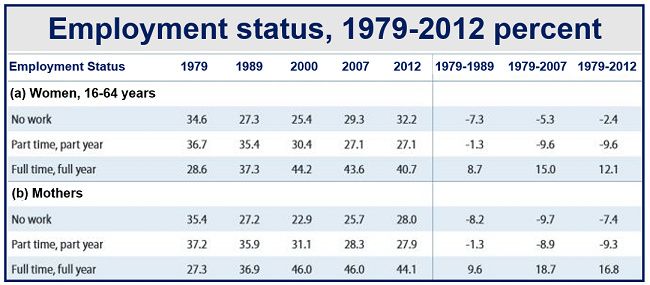Women drove GDP growth in the US by more than $1.7 trillion (annualized) over the last thirty years, according to a new report – “The Economic Importance of Women’s Rising Hours of Work” – by the Center for American Progress.
If women had continued working the number of hours each week they used to thirty years ago, the United States’ GDP (gross domestic product) in 2012 would have been approximately 11% lower.
Women’s contribution to the US economy over the last 3 decades, calculating just the extra hours worked, is equivalent to Social Security, Medicaid and Medicare spending combined.
Women drove GDP growth, not just household income
Co-author Heather Boushey, Senior Fellow at the Center for American Progress, said:
“While much research has focused on how women’s rising work hours have impacted women and the economic well-being of their families, our paper explores how women’s earnings actually affect the strength of the middle-class and the overall economy.”
“The finding that the movement of women out of the home has a measurable impact on GDP and on the middle class make the need to restructure our employment standards for the reality of the 21st century work force even more urgent.”
Since 1982, the proportion of females in the country’s workforce has been steadily rising.
The report finds that this dramatic rise in the number of hours women are working each week has had a significant impact on both household earnings and the overall economy.

(Source: Center for American Progress)
Middle-class household incomes increased
The authors found that:
- The average income in middle-class households would have been considerably lower if female employment patterns had not changed over the last thirty years.
- The share of mothers working full-time all-year-round increased from 27.3% in 1979 to 46% in 2007. During the Great Recession the figure dropped to 44.1%
- Full-time, full-year employment for all females rose from 28.6% of all women in 1979 to 43.6% in 2007, and then fell to 40.7% in 2012.
Full-time, full-year means the person works 50 weeks per year, with a minimum of 35 hours each week.
Median hours worked by women increased dramatically
From 1979 to 2012 the median hours worked annually by females increased by 739 hours – all of the increase occurred during the 1979-2000 period.
Mothers’ median annual hours of work rose by 960 hours over the 30-year period, with all of the increase taking place by the year 2000.
The authors comment that the importance of mothers’ extra hours of work and their contribution to the national economy “lend a new urgency to rethinking US labor standards for the 21st century.”
Despite their enormous contribution to US GDP growth, mothers and women continue to work in a set of institutions that commonly provide very little of the kind of support they need to perform successfully both at home and at work.
Employees should be given more control over their schedules with a right-to-request law, which would implement a national family and medical leave insurance program, as well as allowing workers to earn paid sick days.
Female workers who belong to unions in the US earn considerably more, on average, than their non-unionized counterparts, a study found. They also receive better benefit packages from their employers.
A study found that the US is not only the best country in the world for male, but also for female entrepreneurs. Targeted government policies in the United States are making it much easier for women to set up their own businesses.
US falling behind other advanced economies
US labor laws have not adapted to the changing patterns in the labor market regarding the number of females in the workplace.
Since the 1990s, there has been a plateau in women’s labor-force participation rates, from 74% (25 to 54 year olds) in 1990 to just 74.7% in 2011.
This plateau has not occurred in other advanced economies that have experienced significant increases in women’s labor-force participation.
According to research recently carried out by Francine Blau and Lawrence Kahn of Cornell University, the US has fallen behind most other developed countries regarding women’s labor-force participation. Out of 22 such nations the US ranks 17th.
Blau and Kahn wrote: “Unlike the United States, most other economically advanced nations have enacted an array of policies designed to facilitate women’s participation in the labor force, and such policies have on average expanded over the last 20 years relative to the United States.”

